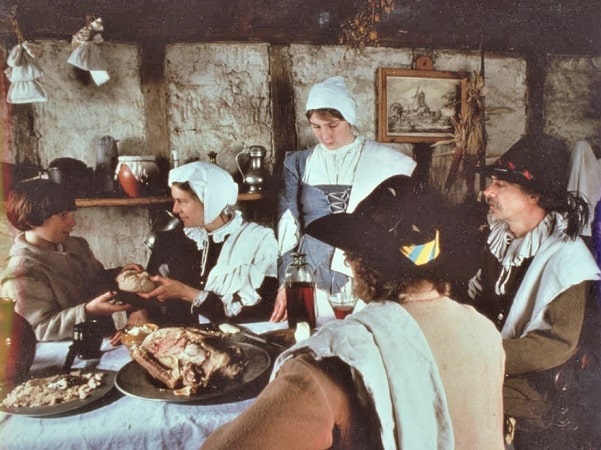Introduction: In this article, Melissa Davenport Berry continues her story about Henry Hornblower II, who was instrumental in establishing the living museum “Plimoth Plantation” and bringing the “Mayflower II” to America. Melissa is a genealogist who has a blog, AnceStory Archives, and a Facebook group, New England Family Genealogy and History.
Today I continue with my series “Mayflower Descendants: Who’s Who.” My last story was about Henry Hornblower II (1917–1985), 11th generational descendant of Mayflower passenger Stephen Hopkins and founder of Plimoth Plantation, a living history museum in Plymouth, Massachusetts (known today as Plimoth Patuxet).
He was also instrumental in the planning of the Mayflower II replica which sailed from England to Plymouth in 1957.
To recap: I found an obituary for Hornblower published in the Patriot Ledger on 22 October 1985 which pays tribute to him and his contribution to the project Plimoth Plantation.
In collaboration with Mayflower descendant families, Hornblower erected a village based on the first Pilgrim site.
Plimoth spokeswoman Rosemary Carroll noted that Hornblower remained in his post as chairman of the plantation corporation up to his death and attended meetings regularly.
In 1959 the Patriot Ledger had published a feature story on the growing popularity of Plimoth Plantation, reporting that it was drawing crowds and attracting all types – from history lovers to Brownie troops.
This article reported on recent exhibits added for that year: an 8-foot deep by 7-foot-long saw pit used to cut timber; and two examples of Indian wigwams. The Mayflower II also received a new coat of paint. A structure completed for the season was built in memory of Mayflower passenger Richard Warren. Another was in process for Samuel Fuller, member of the inner council of the church, who was the only deacon in the fold and the Pilgrim “surgeon and physician.”
Already on location: homes of William Brewster; John Howland; and William Bradford, who is considered one of the most important Pilgrims for his journal recording customs and activities. Other Pilgrim homes are planned, including one for Hornblower’s ancestor Stephen Hopkins, a signer of the Mayflower Compact, who prospered in the new settlement, fathering nine children with two wives.
The Stephen Hopkins House was completed and dedicated in 1969, and as the following article reported:
“Celebrators of the dedication of the new Stephen Hopkins House on the recreated ‘first street’ at Plimoth Plantation saw to it that the hearth was broken in properly.”
Henry Hornblower II was there for the ceremonies, along with other Pilgrim descendants including Thomas G. Buckley, son of Francis Eben Buckley, 11th from Hopkins. The Buckley’s made a considerable donation to build the house. Other noted guests: Ralph C. Weaver, Philip Olson, Webb B. White, and Miss Eleanor Whipple.
Stay tuned for more Mayflower!
Note on the header image: photo of a Pilgrim meal at Plimoth Plantation. Courtesy of University Archives and Special Collections, University of Massachusetts Boston Digital Commonwealth. Permission to publish.
Recent Articles in This Series:
